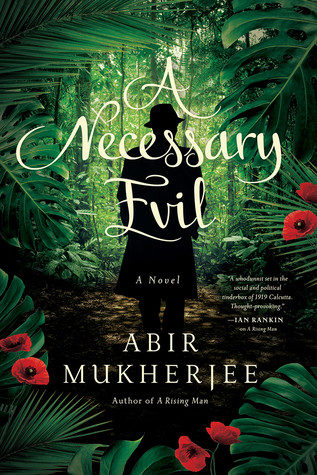A Necessary Evil, Abir Mukherjee, historical mystery
Summary
India, 1920. Captain Sam Wyndham and Sergeant “Surrender-Not” Banerjee witness the murder of the heir of the throne of Sambalpore, a tiny but wealthy kingdom. The two police investigators go there to discover the reason for the assassination.
It’s a complicated situation. Prince Adhir was popular but he may have upset the ultra-religious factions. Certain Sambalpore advisers wish the kingdom to join the newly-formed “Chamber of Princes” in the British-ruled Indian government; others want the country to remain sovereign. The Prince’s father is old, has three wives (and many concubines), and of his two remaining legitimate sons, one is a callous hedonist and the other is an infant. Wyndham’s not certain whether the killing was religiously or politically motivated, but it’s a dangerous situation. He’s warned that others have met untimely deaths. He’s technically not supposed to be investigating the murder, either. Per orders from the British Viceroy, the case is officially closed.
But he’s not one to give up without a fight. He has to find the killer.
This is book 2 of a series but it works well as a standalone novel, too.
I must have a previously unknown penchant for novels set in India between the World Wars. This is the second one I’ve read this year. Both times, the authors present a glimpse of a complicated society that Westerners struggle (or can’t) understand.
- Different religions with contradicting regulations and beliefs.
- Many languages. (No one speaks them all!)
- Multiple socio-economic levels, multiple religious levels.
- And the usual cut-throat politics, gender double standards, and racial/ethnic prejudices.
It’s a place where the ever-present tensions threaten to erupt into war. And it’s supposedly governed by a tiny island halfway across the globe! The setting alone contains conflict and drama to fuel a dozen books. Mukherjee conveyed this complexity without confusing me.
Wyndham may be deluded about his “medicinal” opium use (ha!), but he’s not deluded about his ignorance of Indian cultures. He mentions that “when it came to native idiosyncrasies, the Commissioner, like me, had long since learned that it was best to ask one of their own” (p. 19). It’s a way to introduce cultural details without the reader feeling condescended to. We’re in the same situation as Wyndham: we don’t have a clue. But as another character tells him, “You need to stop believing the things that your English writers are so fond of penning (…) This is India . . . See it for what it really is” (pg. 213-4).
One thing it “really” is? Complex. The hierarchies are never fully fixed. It all depends on one’s point of view. The dominant demographic might not always be whites . . . or royalty . . . or Brahmin. It’s fluid, and as the soon-to-be victim muses, “Who is to say which of the three is most legitimate?” (p.10)
I thoroughly enjoyed this book. I have 4 pages of notes in my book journal, and I could’ve taken more notes! Mukherjee has created intriguing characters in a complex setting. I look forward to reading the first book in the series and any others.
Bonus tips for fiction writers:
As a writer, I’m always on the lookout for technique/theory put into practice. Sometimes I see how to do it, other times . . . well, it’s more how not to do it. Here’s one thing I learned this time.
Avoid cliché by acknowledging its presence.
One twist, while not entirely predictable, could be considered clichéd, a staple of cheap romantic thrillers. (“Cheap” as in bad, not a marked down e-book in a flash sale on Amazon. We’re talking terrible, horrible, no good, very bad fiction.) Wyndham’s internal voice ponders this. “It was the stuff of fiction, the tawdry, titillating staple of those penny romance novels sold on station platforms back home. Surely such things didn’t happen in real life?” (pg. 132). His momentary thought takes the cliché and gives it credibility by acknowledging its incredibility.
Have characters acknowledge their own prejudices.
I’ve written before about the dilemma of historical novelists: how to create a believable character who is both sympathetic to modern readers and who holds the predominant (and now unfavored) views of that historical period. Sometimes authors make their characters “modern” in their views. But that can be tricky and, if not handled well, be unbelievable.
Here Mukherjee allows Wyndham to be racially prejudiced. He’s not entirely prejudiced against all people of color. He likes, respects, and even shares living quarters with Surrender-Not. He knows that white superiority is nonsense. But when it comes to interracial love, he’s conflicted. Sure, he’s attracted to a woman who’s not “lily white.” But a native man loving a white woman and her loving him back? Somehow that bothers him. He doesn’t want to dwell on why, yet he acknowledges that he’s upset by that possibility. To me, this deepened his character and made him believable for this time period.


